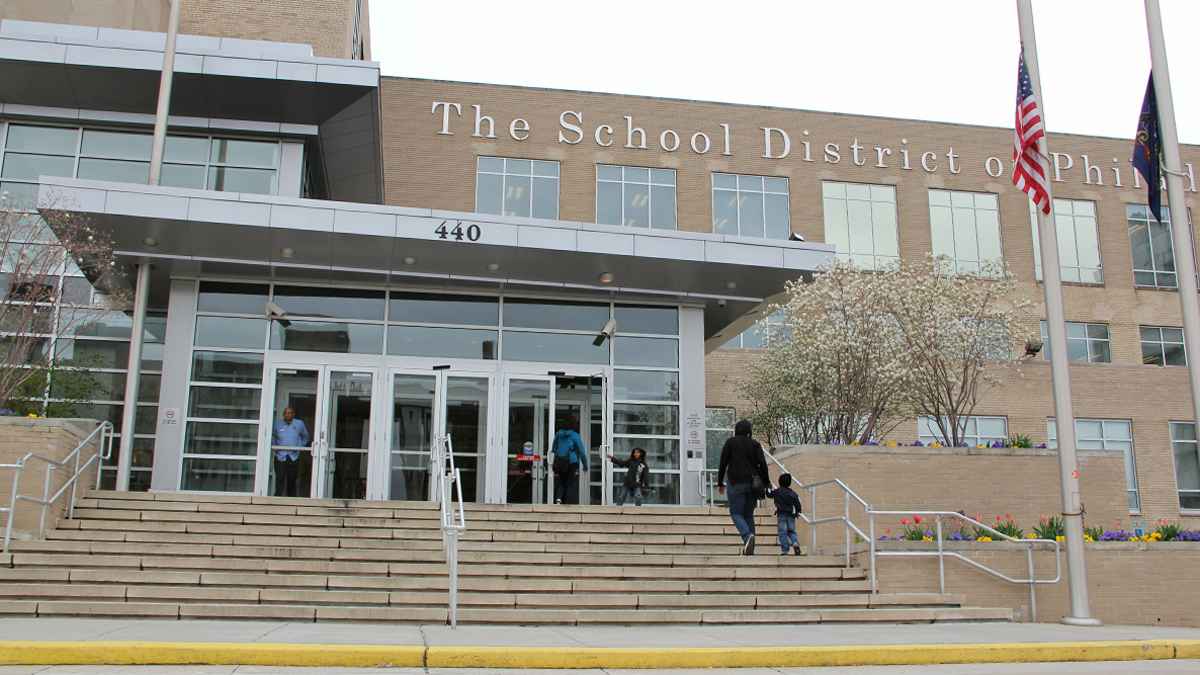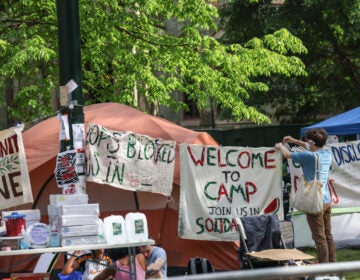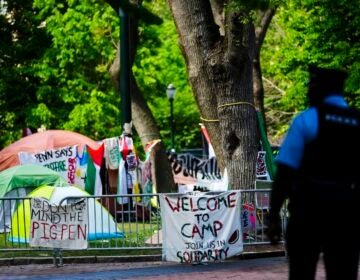After grilling from Council, Philly district answers questions on suburbanites in city schools

School District of Philadelphia (Emma Lee / WHYY)
Every spring, City Council members pepper School District of Philadelphia officials with questions during the district’s annual budget hearing.
And every spring, district officials dutifully return with answers to those queries.
This year’s batch of responses came out in early June, about a month after the initial hearing. They contain some interesting nuggets on the district’s operations and policies, covering topics from magnet school attendance to the sale of old school buildings to ICE activity in Philadelphia’s public schools.
We’ve attached the district’s full response at the bottom of the page. Below we dive into some of the more intriguing answers.
Attracted to the arts? Suburbanites in city schools
Back during the May hearing, after questioning from Councilman Bill Greenlee, the district revealed there were suburban students paying tuition to attend desirable city schools. That revelation prompted a cascade of rebukes and led to a more detailed report on non-Philadelphia residents attending district schools.
In all, there are 41 non-residents attending 24 city schools. The plurality, however, are children in the foster system who were placed in a home outside the city by Philadelphia’s Department of Human Services.
Another 10 students pay to attend Philadelphia magnet schools. Of those 10, seven go to the Philadelphia High School for the Creative and Performing Arts (CAPA), long considered the city’s premier arts magnet school. The Arts Academy at Benjamin Rush, Central High School, and the Workshop School, each have on suburban student on the rolls.
At the May budget hearing, district officials said the tuition payments don’t profit the school system, but instead covers the average cost of educating a student.
Though the total numbers are small, Greenlee still bristles at the idea of seven suburbanites earning admissions slots at CAPA that could have gone to city kids.
“Aren’t there 7 kids from Philadelphia that would meet their criteria,” Greenlee asked.
Suburbanites can pay $9,821 a year to attend secondary school in Philadelphia and $8,735 to enroll in a city primary school–although there are no reported cases of the latter.
The state department of education sets those rates, and Karyn Lynch, the district’s chief of student support services, noted that many districts across Pennsylvania have “policies that look just like ours.”
Lots of districts say they’ll accept students from out of district who want to pay tuition, Lynch said, but many don’t follow through on that promise. Philadelphia does, and suburban students who want a place at one of the city’s top magnet schools go through the same application process as resident students, Lynch said.
“We’ve got some really great schools people want to attend,” Lynch said.
That said, the district’s policy on out-of-district students is now up for review by the School Reform Commission. There’s no word yet on whether Philadelphia’s public school system will shift course.
Old schools, new cash
In addition to their report on non-residents in city schools, district officials also provided an update on their ongoing efforts to sell shuttered city schools.
The update contained info on 38 buildings closed since 2005. Of the 38, 29 have been sold over the last four years for a combined price of $74.525 million. Another seven schools are still waiting for a buyer, including three that closed at least a decade ago. One school, Thomas FitzSimons in Strawberry Mansion, has an agreement of sale, while another, the old Samuel Fels building near Oxford Circle, will be demolished this fall.
Shortly after the old Fels building closed in 2013, the district attempted to sell it for $4.5 million.
Of the 38 buildings on the list provided to City Council, 22 closed at the end of the 2013 school year. Those closings were part of a historic downsizing plan that drew heavy scrutiny.
Almost exactly four years later, the district has sold 16 of the 22 shuttered buildings and reached an agreement of sale for one more. Four schools–Communications Tech, Fairhill, George Pepper, and John Whittier–remain on the market.
Meanwhile, the old Ada Lewis Middle School in Germantown and the former William Pierce School in Graduate Hospital closed almost exactly ten years ago and are listed for sale. A since-closed annex for Dimner Beeber Middle School is the oldest former school building on the market, having shut its doors in 2005.
Had the district run this report a couple months earlier, there would have been significantly more properties still awaiting sale. That’s because there’s been a flurry of activity recently.
On May 19, the district completed sales on five buildings: Charles Carroll, Robert Fulton, Germantown High School, Abigail Vare, and Walter Smith. The Concordia Group, a Maryland-based developer, bought all five schools as a package, but ended up flipping Smith after pushback from neighborhood activists who opposed Concodria’s plans to build condos on the lot. Local developer Ori Feibush and a partner ended up buying Smith, which sits in the gentrifying Point Breeze section of South Philadelphia.
One day before the five-building sale, the district unloaded Robert Vaux in a $2 million deal with the Philadelphia Housing Authority (PHA). But the building won’t drift far from district orbit. In partnership with the PHA, the district will open a new school inside the old Vaux building this fall.
ICE policy a no go
Since the November election, various lawmakers and activists have pushed the district to craft new policy around protecting undocumented students or state affirmatively that federal immigration officials can’t enter school buildings. District officials have demurred. Council asked if the district’s School Reform Commission (SRC) would introduce a policy related to immigration officials entering schools. The district response:
“Commissioners will not take formal action on this request.”
The district did add that its schools “will remain safe havens for many students who seek support, advice, direction, and refuge.”
That response jibes with the district’s standard line over the past several months. The district has ramped up trainings to ensure staff know what to do if immigration officials arrive at a school. It has also circulated FAQ sheets on the topic.
In general, the district has said its employees should refer any federal immigration requests to district lawyers and bar immigration officers from entering school grounds or retrieving information about students. But the district has resisted any calls to change its official policies, arguing its current rules are sufficient to ensure the security of undocumented students.
Also of interest
— The district told council it has one school nurse for every 725 students. That’s actually better than the 750-to-1 ratio recommended by the federal government through its Healthy People 2020 initiative, a compendium of public health benchmarks.
— In response to queries from Councilman Alan Domb, the district said it will introduce more courses on financial literacy.
WHYY is your source for fact-based, in-depth journalism and information. As a nonprofit organization, we rely on financial support from readers like you. Please give today.





